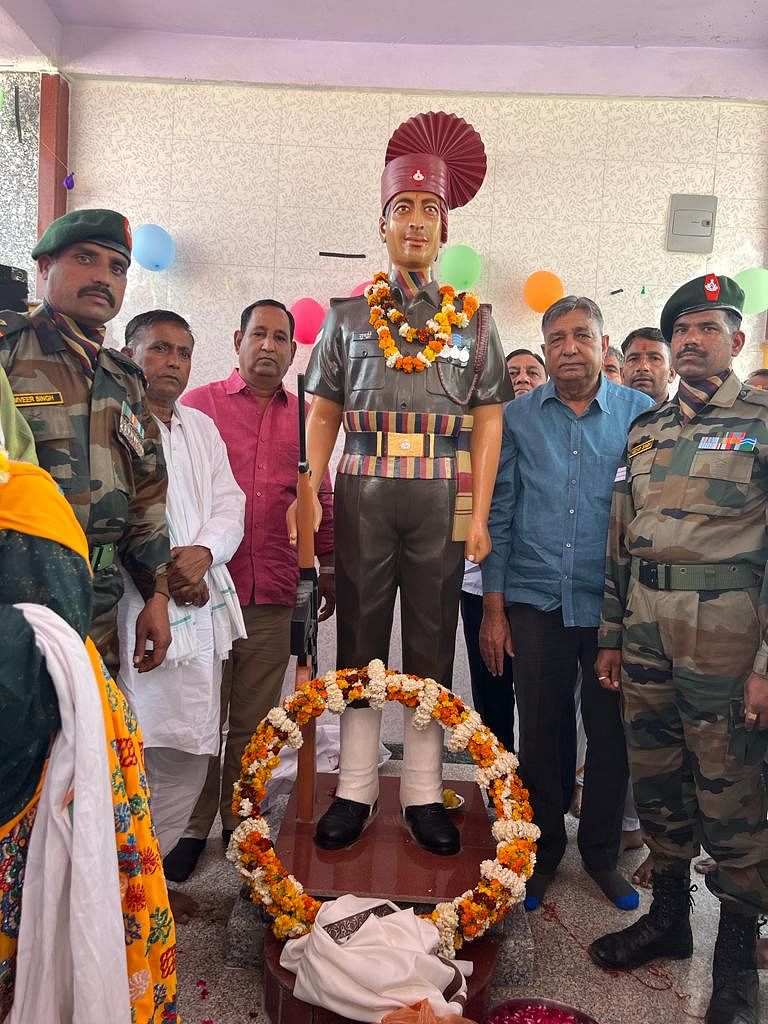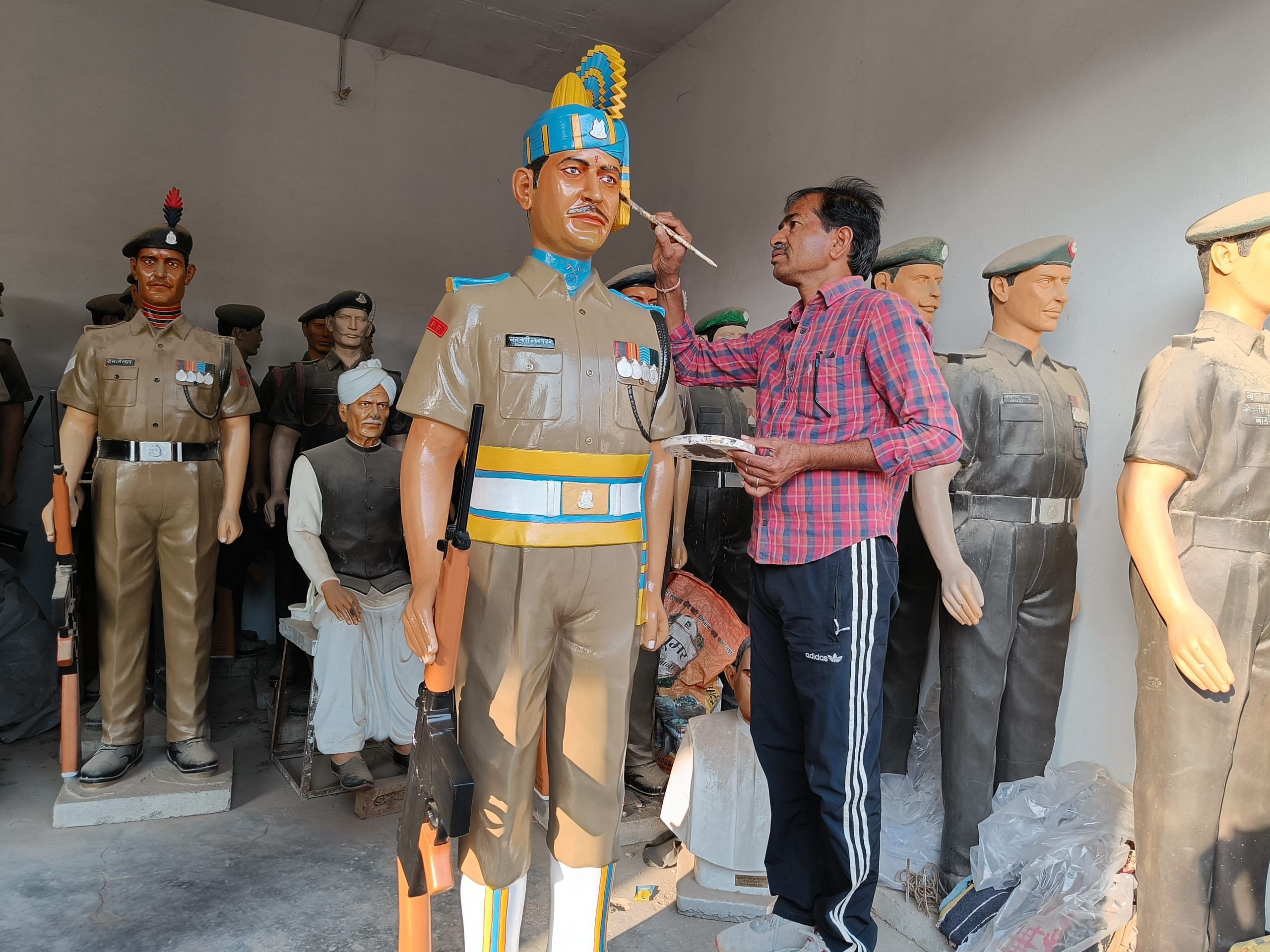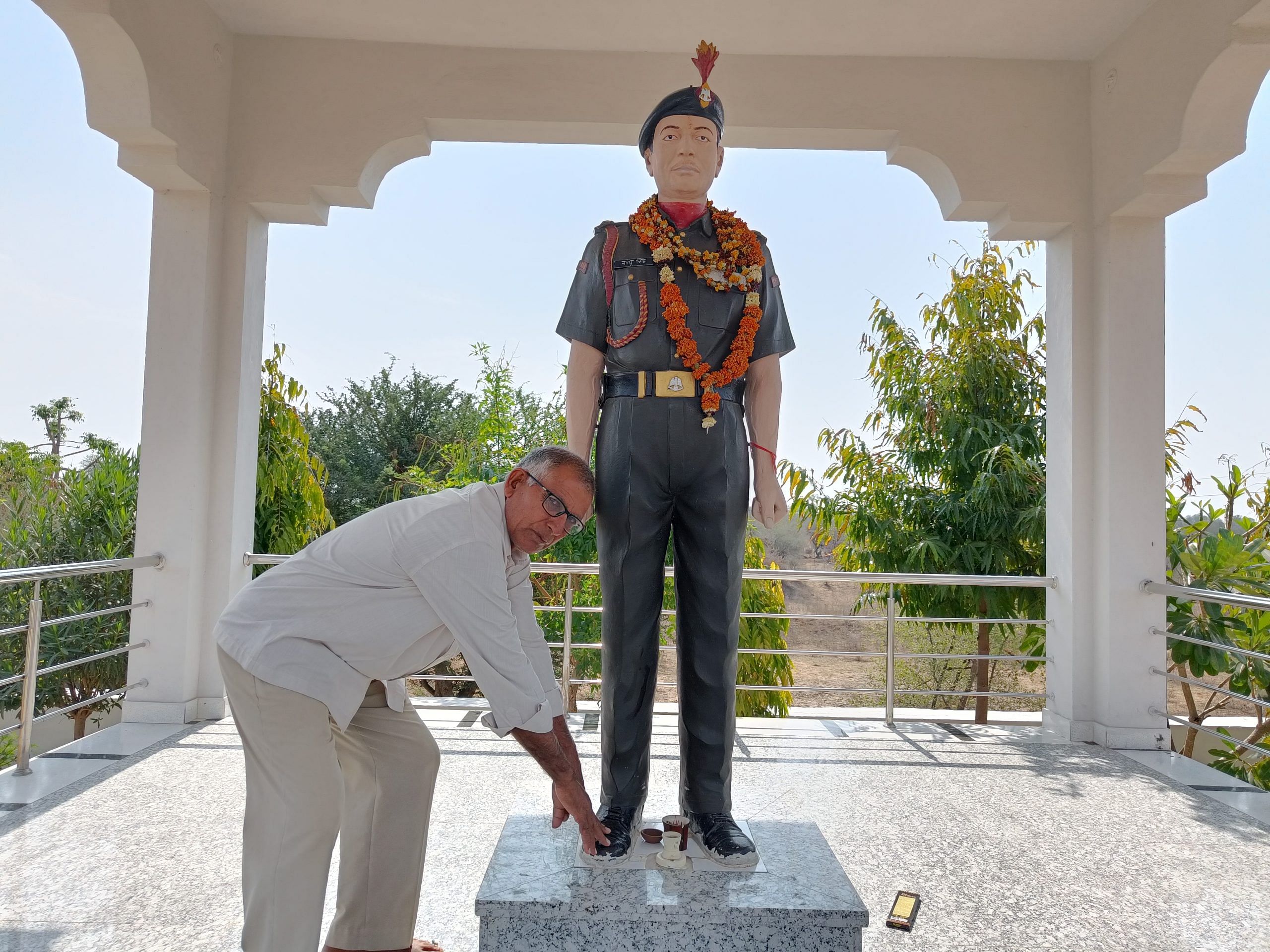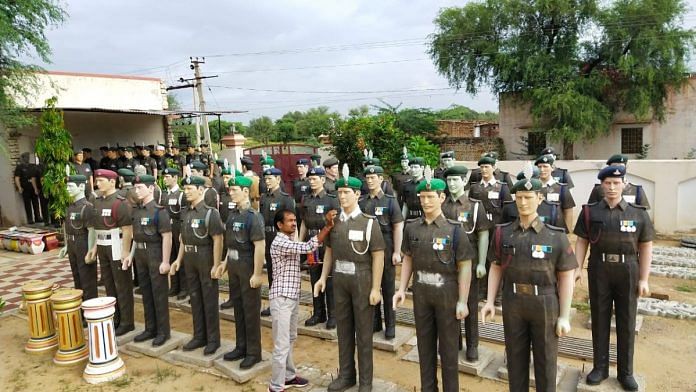Jhunjhunu/Sikar: A new wave of nationalism is sweeping through the desert state of Rajasthan, and sculptor Virendra Singh Shekhawat is at the heart of it. Everyone wants a piece of him. At his workshop in Khudania village in Jhunjhunu district, his phone rings non-stop with requests from bereaved brothers, sisters, mothers and fathers who want him to make statues of their sons and brothers who died on duty while serving in the Indian Army.
It’s become so trendy to have a statue, that Shekhawat gets requests for soldiers who died in the India-Pakistan wars as well as the 1962 war with China.
Earlier only statues of soldiers who died in battle were installed. “But now statues have started being installed even for soldiers who died normal deaths [during their service in non-combat operations and during peacetime],” said Shaurya Chakra awardee Colonel Ranveer Singh, retd, who oversees the operation of the Army Hospital in Jhunjhunu.
Shekhawat has made 700 statues since 2018, of which 450 have already been unveiled. The remaining are in his workshop waiting to be shipped to their families—most of whom are from Sikar, Jhunjhunu and Churu districts. These three districts contribute the largest share of young men from Rajasthan to the armed forces. Of the 80,000 Army personnel from Rajasthan, more than 50,000 are from Jhunjhunu and Sikar alone. These two districts, referred to as ‘Sainiko ka Zila’ (soldiers’ district) also have the maximum number of men to have died while serving the Indian armed forces, said Prem Prakash, assistant administrative officer, Zila Sainik Kalyan Karyalaya, Jhunjhunu.
This trend was fuelled by then Neem Ka Thana MLA and Sainik Kalyan Board chief Prem Singh Bajor who announced in 2018 that he would set aside Rs 25 crore for 1,170 statues of soldiers from the state. For Bajor, they are symbols of national pride and a reminder of Rajasthan’s contribution to safeguarding India’s borders.

“A country which does not have the spirit of nationalism can collapse at any time,” he said.
The life-size statues occupy pride of place in front of hospitals and schools, and along highways, thoroughfares and parks. Shekawat’s life-like creations, complete with their medals and insignia, have become status symbols for families, selfie points for visitors, and a podium for politicians, protesters and preachers.
“Since I put up my husband’s statue three years ago, our respect in the village has increased. People come to the statue to seek my husband’s blessings after buying bikes or getting married or tying rakhis,” said Bino Devi from Posana village, whose husband, Nayak Subedar Dharampal Singh from the Jat Regiment lost his life in 2009 due to an accidental death while posted in Jammu and Kashmir.
Though she didn’t have to pay for the statue itself, it still cost her Rs. 5 lakhs to have it installed.
Bajor’s mission to immortalise the dead soldiers has won the hearts of rural Rajasthani families, but has ruffled a few feathers as well. Not everyone is a fan.
“Earlier, idols were installed on a small scale, but now this trend has increased over the last two-three years,” said Rajasthan Sainik Welfare Board president and Congress leader Manvendra Singh Jasol, the frustration clearly evident in his voice.
“I am not in favour of idols. They are not properly maintained and cleaned. Birds sit on them, which is an insult to the martyrs. It is better that schools, colleges, and hospitals be named after them,” said Jasol.
But villagers don’t see it that way.
Also Read: Soldier statue in Pakistan removed. Some say it was Hari Singh, others don’t even name it
Pride of villages
Grand statues line the highway leading to Pilani—at least 20 on either side. Posana village in Sikar district alone has five statues.
Along with Jhunjhunu and Churu, Sikar is part of the arid Shekhawati region where crops fail and poverty is rife. Lack of education is another barrier. “Because of this, the people of this region turn to the Army,” said Colonel Ranveer Singh.
For generations, Posana has been sending its men to defend India’s borders. In the village of 4,000 people, 58 people are currently serving in the Army and 44 in the paramilitary, while 82 are pensioners. For them, the five statues reflect their history and contribution to the country.
The statues wouldn’t have been installed had it not been for 65-year-old Nanddev Subedar. After contacting Bajor for funds, he spent four years doing the rounds of local government offices for permission. He even went to the Rajputana Rifles Regimental Center in Delhi to dig up details about the men who died because nobody in the village had records.
“I am living on a pension but had a dream to build a memorial so that the martyrs of the village get respect,” said Subedar, a former Army man himself.
On 15 August 2021, at least 10,000 people, many from distant villages, gathered for the grand unveiling. An auto outfitted with a mic was driven from village to village and invitations were broadcast on loudspeakers.
“One who has come into this world is bound to die, but it is not in everyone’s destiny to die for the country,” a male voice crackled through the speakers.
Even though Bajor paid for the statues, the family of the five martyrs, led by Subedar, collected money to level the land and set up a memorial. The statues are enclosed in a metal grille, and a concrete roof offers a measure of protection from bird droppings and dust. Inside, colourful LED lights add a bit of drama. According to villagers, people always stop to take photos, while others touch the feet of the Posana heroes.
Every village in this northeastern belt of Rajasthan wants similar statues and memorials.
Genesis of the idea
Bajor claims to have met every family in Rajasthan who has lost a loved one to war. In 2017, he took out a ‘Shaheed Sainik Samman Yatra’ of more than 1 lakh kilometres from Dhanuri village in Jhunjhunu. At the time, he was the Sainik Kalyan Board chief.
It was an elderly woman who planted the seed of the idea in his head. “During a visit, she told me, ‘I have heard that you are a man with money. Install a statue of my son,” said Bajor.
He met with then-Chief Minister Vasundhara Raje, but she rejected his proposal. The government didn’t have the funds to spare.
“Vasundhara ji said that if the government installed the statue of the old lady’s son, then tomorrow someone else would come and demand a statue,” he recalled.
It was then that Bajor decided to use his own money to make the statue and he would not stop with just one. He was going to honour all of Rajasthan’s soldiers. Bajor’s wealth comes from business, he declared assets worth 142 crore in 2018.
He contacted Shekhawat who agreed to make statues of soldiers for around Rs 1.5 lakh each.
The most recent statue was installed on 13 March in Rihod village. Over 5,000 people, including serving soldiers and police officers, gathered to remember Bhauriya Ram who died in the India-China war.
Bajor is the chief guest at every unveiling. In his speeches, he says that fallen soldiers should be worshipped like God.
Also Read: Pulwama wives’ demand for jobs dodgy enough. Gehlot caving will encourage exploitation
Khudania’s pride
If the statues are like deities, then Virendra Singh Shekwat is doing god’s work.
“Just like you get peace by worshipping in the temple, similarly I get it by making statues. It feels very good when they go to their families,” he said at his workshop in Khudania village.
The desert wind blows in the afternoon, lifting little eddies of dust that collide into the chests of the soldiers who stand tall and proud in their uniforms and medals.
He is inundated with calls. “When will my statue be ready? I want to place an order for a statue?” The demands rarely vary.
“Earlier, I used to get some rest but ever since I started making these statues, life has become chaotic. But I love it, it’s a passion,” said Shekhawat.
His biggest challenge, and one he enjoys, is to make statues “look alive”. For this, he needs details of their rank, regiment, and badge. Every physical detail is important, their height, the length of the nose, the arch of the brow. “The height of the statue is kept slightly higher so that the ‘raub’ (aura) is visible.”

Iron, concrete, gravel, and cement are needed to make these statues. And then he sets about painting them. The uniforms have to be the exact same shade, and the detailing on their insignia and medals are equally important, he said.
Sculpting and painting have been his passion since he was in class three, and now, it has made Shekhawat, the most respected person in his village.
“Today Khudania village is being identified by my name. It has become a tourist point. School children from far and wide come with their teachers to see these idols,” he said.
He is regularly featured in the media. ‘Shaheedo ko amar kia jhunjhunu ke murtikar virendra shekhawat ne’ (Jhunjhunu sculptor Virendra Shekhawat imortalises the martyrs) to ‘Shekhawat ke ghar shaheedo ki fauj’ (In Shekhawat’s home, an army of martyrs) are some headlines highlighting his work.
For the first time on Republic Day this year, the people of his village took part in the Tiranga Yatra, a national campaign promoted by the Narendra Modi government ahead of the 75th year of Independence. One of the stops was Shekhawat’s shop.
The shop has also been the location of a patriotic song’s music video. Manoj Bhuriya, a resident of Islampur in Jhunjhunu, composed the song when he read about Shekhawat and his statues in an article published in the Rajasthan Patrika.
“We were writing a new song for school children to sing on 26 January. That’s when we came to know about this place where so many idols are present at the same time. It proved to be a good place to shoot,” said Manoj. The video was for his daughter’s YouTube channel.
Bajor has even contacted the Limca Book of Records and the Guinness World Records to see if his achievement of creating so many statues of soldiers can get him a mention; he is yet to receive a response.
Also Read: Fallen jawan’s family refuses Shaurya Chakra sent by courier. What’s the 4-yr dispute behind delay
Idol worship
The one exception to the statue craze is Dhanuri village also in Jhunjhunu district.
Including the two World Wars, 17 soldiers from this village have died in combat. More than 250 residents are former servicemen, and according to a report in The Times of India, at least a hundred villagers are currently serving in the Army “from sepoy to brigadier”. This village, where a majority of its residents are Muslims, reportedly has the highest number of soldiers across Rajasthan who died while on duty, according to Mohammad Hafiz, who was the Sarpanch of the village for more than 25 years.
Most of the residents are from the Kayamkhani community, who trace their ancestry to the Rajputs.
“Our ancestors were Rajputs who became Muslims during the time of Firoz Shah Tughlaq. Since then our community has been associated with the Army,” said Hafiz, whose brother Major MH Khan was the first officer from this community who died after Independence. He lost his life in the 1971 India-Pakistan war.
But there are no statues of him or any of the other ‘fallen heroes’.
“Islam is against idol worship. That’s why we are not making idols of the martyrs of our community,” said Hafiz.
But a grand ‘KK Memorial Shaheed Smarak’ is being built in Dhanuri, along the lines of the National War Memorial in Delhi, in honour of the soldiers. Chief advisor of the memorial, Bhanwar Khan, said that this memorial is being built in memory of the people of the Kayamkhani community. “There is a plan to put inscriptions of all 331 martyrs from this community,” he said. The memorial was built with money crowdfunded from members of the Kayamkhani community across the state.
Land allocation
One of the biggest hurdles for families is land availability and getting permission to install a statue.
Pastures and land used for water harvesting and farming (Gochar, Charagah or Johad land) can no longer be allotted for the purpose of installing statues, said an official of the Revenue Department of Jhunjhunu Collectorate, citing a recent stay order by the Rajasthan High Court regarding encroachments on public land.
However, this land [Gochar, Charagah or Johad land] was allotted before the stay, the official said.
“Only Sivachak land (barren, rain-fed land) can be allotted by the district administration. In the past, we have also allotted such land for martyrs’ memorials,” he said.
It’s also becoming a thorny political issue ahead of the elections. Earlier in March, the wives of the three CRPF personnel who died in the 2019 Pulwama attack, staged a dharna in Jaipur demanding statues and jobs.
A family seeking public land to set up a statue has to jump through multiple hoops. First, a proposal is passed in the Gram Sabha at the village level, from where it is sent to the tehsil, after which the file goes to the collector for permission through the SDO’s office.
Often, statues are installed without the requisite paperwork. A grand statue of Shaheed Naib Subedar Nathu Singh stands along the Jaipur-Delhi State Highway at Dhigal in Jhunjhunu, in front of C.K.R.D.M Nursing College. The statue was garlanded on 21 February 2018, on his Shahadat diwas. The family spent Rs 15 lakh to construct the memorial.

But there is no written record that permission was granted to the family.
“We tried for a land allotment, but no one gave it in writing. At the behest of Bajor Sahib, the administration verbally allowed us to build this memorial on this land,” said Nathu Singh’s brother Hetram Singh.
“In reality, it could be called an encroachment,” he said, confident that the statue is unlikely to be pulled down.
(Edited by Theres Sudeep)



